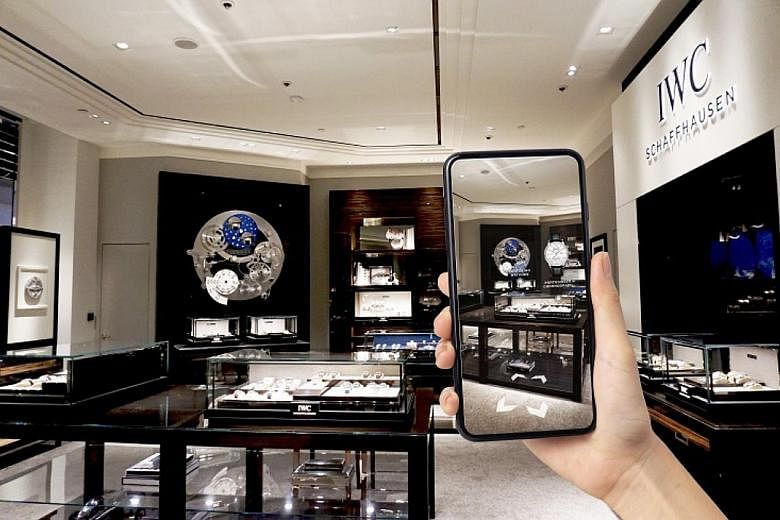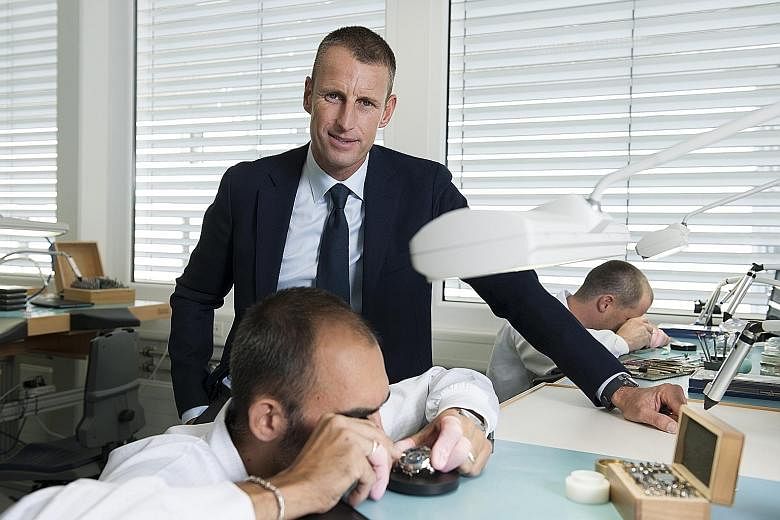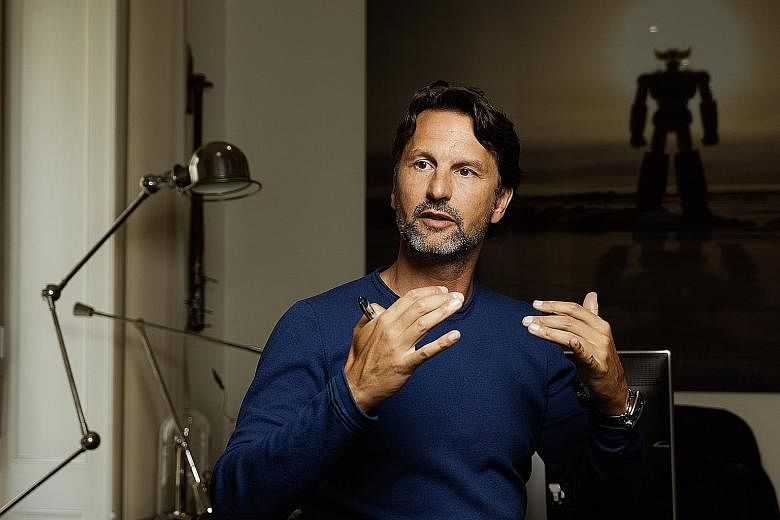NEW YORK • It has taken a pandemic - with shops closed around the world and sales plunging - but some high-end watch brands are finally moving into the digital era.
From augmented-reality filters that let you "try on" a watch at home to chatbots that connect clients with virtual sales assistants, the rapidly expanding use of technology is striking for an industry whose three best-selling brands - Audemars Piguet, Rolex and Patek Philippe - do not support e-commerce.
And where online experiences still are considered at odds with the very essence of luxury.
Yes, other industries moved into the arena years ago. But the speed at which watch sellers now are migrating online - and reaching out directly to the public - reflects a suddenly urgent need to keep pace with consumers accustomed to digital engagement, either because they have hardly known a world without it or because the coronavirus outbreak has demanded it.
"It's crazy how fast it goes," said Mr Marco Gabella, a co-founder of the watch site Watchonista. "Brands have been afraid of digital for a long time and now that fear is evaporating."
To appreciate how literally the industry's chief executives have interpreted the concept of going direct, simply hop on Instagram or join one of the trade's by-now-ubiquitous Zoom presentations.
"Three weeks ago, I had no idea what an Instagram Live was," said Mr Maximilian Busser, founder and creative director of the Geneva-based independent brand MB&F. In mid-May, he used the platform to showcase 55 Minutes, a series of interviews with fellow watch executives and designers. "Now we have these formats where we're so much closer and so much more humane."
Mr Busser's first guest was Mr Patrick Pruniaux, chief executive of two Kering-owned luxury watch brands, Ulysse Nardin and Girard-Perregaux.
Mr Pruniaux is a former Apple executive, who joined the tech giant in 2014 to work on the first generation of its smartwatch. He has embraced video conferencing to stay connected with employees and clients during the pandemic.
In May, he conducted one-on-one Zoom and Microsoft Teams chats with VIP clients to pique their interest in the Freak X Blue Bucherer, a limited-edition watch that Ulysse Nardin and the Swiss retailer Bucherer released in June.
"I don't see these as selling sessions," Mr Pruniaux said. "Very often, we just describe the product, but the video conference, and the fact that we can bring people on board that were there at the origin of the product, adds more value."
GENERATING CURIOSITY
While sales are the ultimate goal, much of the latest technology is designed to generate curiosity that would lead potential clients to engage with a brand online.
On May 15, for example, the Watches of Switzerland Group, the Leicester, England-based owner of numerous multi-and mono-brand stores in the United States and Britain, co-hosted a Zoom news conference with the Japanese watchmaker Grand Seiko to preview a new timepiece, the Toge Special Edition.
There had been plans to unveil the model in early April at a pop-up shop in Manhattan, but the crisis forced the partners to change course.
"When we started talking about this project over a year ago, I was imagining a big party in our New York store and maybe some Japanese whiskey," Mr David Hurley, executive vice-president of Watches of Switzerland Group, said during the Zoom event.
Instead, Grand Seiko worked with Facebook's Spark AR Studio software to develop an augmented-reality filter - what Watches of Switzerland called a first of its kind for the industry - that enables people to project the watch onto their wrists, size a hologram of the timepiece up or down, rotate it and, crucially, snap a photo to share on social media.
"At first, I did not associate this technology with our brand - especially because our collectors always talk about the quality of our dials and finishing," said Mr Brice Le Troadec, president of Grand Seiko Corp of America.
"But we've been trying to find creative solutions outside of what is normally done in our industry."
IWC Schaffhausen, one of eight speciality watchmakers owned by the Swiss giant Compagnie Financiere Richemont, can relate.
In late April, the brand used augmented reality to highlight its 2020 Portugieser collection, which debuted through the online edition of the trade fair Watches & Wonders. A month later, it rolled out a Facebook chatbot pilot program, giving online customers direct access to a virtual adviser.
Also in May, IWC opened its first Virtual Boutique, a 360-degree digital reproduction of its flagship store in Singapore's Ion Orchard mall, and hosted two events for selected clients complete with mix-your-own cocktails, including a Negroni and a Sakura Martini, delivered via snail mail.
"We also provided a matching Spotify playlist to create the same vibe for everyone," IWC's chief executive Christoph Grainger-Herr wrote in an e-mail. "Customers could walk around in the virtual boutique, look at watches and interact with each other as well as with an IWC sales associate."
The one thing customers could not do: Buy watches.
CHALLENGE TO SELL ONLINE
For most watch brands and dealers, getting up to speed on basic digital strategies that have the potential to jump-start sales has become a top priority.
"Creating choice for how you shop or physically get the product - most of that will be quite sticky," said Mr Steve Noble, a senior partner with McKinsey & Company, based in Minneapolis. "Some customers will crave a face-to-face interaction, another group will crave interaction but not physically, while others will want an entirely contactless process."
Acknowledging the new reality, some former e-commerce holdouts have moved into direct-to-consumer online sales including Hublot, Ulysse Nardin and Zenith.
Mr Pruniaux said: "We know the vast majority of the experience of buying a watch starts online.
"E-commerce just continues the experience, and whether people buy online from our partners or our site, we want the experience to be good."
Watchmakers also want the experience to be consistent - but pricing can vary widely depending on customers' locations (prices vary from country to country) and whether they buy directly from the brand or a multi-brand retailer, as wholesale partners are not obligated to sell watches at full retail price.
"It's all about discounts," said Mr Ali Mudara, founder of Projekt8, a luxury watch boutique in Bahrain. "Customers come to the store and they negotiate a price. Why buy online if they get it cheaper in store?"
The Swiss watch industry's motley approach to pricing is not the only obstacle to creating a seamless omni-channel offering for would-be buyers.
Many of the world's finest watch retailers - including the Hamburg, Germany-based Wempe and The Hour Glass, headquartered in Singapore - simply are not equipped to sell online.
And as purveyors of the Big Three brands, they are not incentivised to do so.
"We are not going to go and sell on the Internet tomorrow, but that doesn't mean we are not looking at it," said Mr Francois-Henry Bennahmias, chief executive of Audemars Piguet. "We are managing scarcity, anyway. So it would be a little counterproductive to offer watches online that we cannot deliver."
If only all watch brands had such problems.
With sales of Swiss timepieces down by double digits in every major market, the prospect of unsold inventory means companies are scrambling to revamp their distribution models. While offering direct digital sales is one way to do that, the decision has vast consequences for an industry built on relationships with wholesalers.
To prepare for a future in which they may find themselves in direct competition with their suppliers, many watch retailers have become tech converts, preaching the gospel of Zoom events and online chat functionality.
Mr Oliver Smith owns a namesake watch and jewellery boutique in Scottsdale, Arizona, and a Panerai boutique in Aspen, Colorado.
He said he woke up one day in May, "and it hit me: I think we could sell some of our products on Zoom".
On May 15, he used the platform for an online auction of 35 pre-owned timepieces. "We sold all but one, maybe two watches, including an A. Lange & Sohne Datograph for US$42,000 (S$57,500) and an Aquanaut from Patek for US$30,000."
Around the same time, he added a chat feature on his website and appointed a salesman to respond to online queries. "We sold US$65,000 worth of watches in the first week, which we would never have sold before," he said.
Mr Greg Simonian, president of the luxury watch retailer Westime in Los Angeles, recruited his wife Nicole Simonian to help him and the Breitling USA president Thierry Prissert present the Swiss brand's latest collection to about 30 clients during a Zoom happy hour.
To make the May 7 event more festive, Mr Simonian, apparently following the same playbook as IWC, arranged for cocktail-making kits from a local distiller to be delivered to attendees. Then, via Zoom, "we had a mixologist show them how to make the perfect Old-Fashioned".
"I think people found it fun," he said. "For us to have the product and show it and explain the feel of it - I think that means something."
And that is why watchmakers, in the great tradition of all luxury makers, continue to be reticent about online sales. They cling to the notion that a luxury purchase is most appealing when a prospective buyer can touch and feel the product.
So where does that leave watch brands and retailers struggling to effectively showcase a product prized for its tangible qualities in today's environment, where touch is either prohibited or limited by social distancing?
"Virtual reality, Zoom, whatever it is - the focus will be on technology responding with a whole new world of opportunity that will make what we have now seem like just the beginning," said Mr Peter Noel Murray, an expert in consumer psychology who is based in New York City.
"The in-store experience may never be able to be replicated, but what choice do we have?"
NYTIMES



